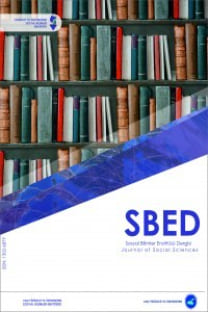TERRY EAGLETON’IN ELEŞTİREL DÜŞÜNCESİNİN KASIM TEVFİK’İN ROMANLARINA YANSIMALARI
Eleştiri biliminin önde gelen temsilcilerinden Terry Eagleton, Edebiyat Nasıl Okunur? adlı eseriyle okuyucuyu daha derin yorumlara yönlendirdiği gibi yazarlara da yol göstermektedir. Zira, eserin giriş cümleleri, kişilikler, anlatı ve edebi değer hem okuyucu hem de yazar için temel öğeler olduğu açıktır. Eagleton’un edebiyat eleştirisi, sahip olduğu Marksist düşünce ile birlikte etkisini tüm dünyaya yaymıştır. Eagleton’un etkilediği en önemli çevrelerden birisi de Modern Arap Edebiyatı olmuştur. Zira bu dönemde öne çıkan edebiyatçıların çoğu fikirsel olarak kendilerine yakın görmektedirler. Eagleton etkisinin görüldüğü Arap Edebiyatçılarından birisi de Filistin asıllı Ürdünlü romancı Kasım Tevfik’tir. Toplumsal eleştiri üzerine kurduğu anlatılarla öne çıkan Tevfik, edebiyatı, toplumda var olan ancak kimsenin dile getiremediği çarpıkları cesaretle yazmakla övünmektedir. Yazmış olduğu romanlarının Arap toplumunda meydana getirdiği etkiye bakıldığında, bunda başarılı olduğu söylenebilir.
Bu çalışmamızda, Tevfik’in, Sahab/Haykırışlar, Mira, Hanetun fevka turab/Toprağın Üstündeki Meyhane romanları başta olmak üzere, romanlarındaki Eagleton’un edebi eleştiri düşüncesinin izlerini bulmaya çalışıp ikili arasındaki etkiyi ortaya koymaya çalışacağız. Bunu yaparken şu sorulara cevap bulmaya çalışacağız: Romancı, dürüst ve tarafsız bilgiye dayanmak zorunda mıdır? Anlatı insan ve toplum hakkında yanlış bilgiler verip bir algı oluşturur mu? Kültürün, toplumları sarsan toplumsal ve siyasal etkisi nereye kadardır? Eagleton’un edebi eleştirisi ile Tevfik’in edebi yazınları arasında ideolojik kesişme noktaları nelerdir?
Anahtar Kelimeler:
Terry Eagleton, Kasım Tevfik, edebi eleştiri, roman, kişilik, değer
THE REFLECTIONS OF THE CRITICAL THOUGHT OF TERRY EAGLETON IN QASSEM TAWFIQ’S NOVELS
Terry Eagleton, one of the leading representatives of the science of criticism, guides the reader to deeper interpretations with his book "How to Read Literature?" In addition, he directs the reader to deeper interpretations and guides the authors. It is clear that the introductory sentences, personalities, narrative and literary value are essential elements for both the reader and the author. Eagleton's literary critique, along with his Marxist thought, spread his influence all over the world. One of the most important circles influenced by Eagleton was Modern Arabic Literature. Because most of the prominent writers of this period regard themselves as intellectually close to themselves. One of the Arab writers with the influence of Eagleton is the Palestinian-born Jordanian novelist Qassem Tawfiq. Tawfiq, who stands out with his narratives on social criticism, prides himself on boldly writing literature, the distortions that exist in society but which no one can say. When we look at the impact of his novels on Arab society, we can say that he was successful in this.
In this study, we will try to find the traces of Eagleton's idea of literary criticism in his novels, especially the novels of Tawfiq, Sahab/Screams, Mira, Hanetun Fevke Turab/Alehouse on the Earth and try to reveal the effect between the two. In doing so, we will try to find answers to the following questions: Does the novelist provide honest and impartial information? Does the narrative give false information about people and society and create a perception? Where is the social and political impact of culture that shook societies? What are the ideological intersections between Eagleton's literary criticism and Tawfiq's literary writings?
Keywords:
Terry Eagleton, Qassem Tawfiq, literary criticism, novel, personality,
___
- Eagleton, T. (2012). Fikretu’s-sekafeti. Celal, Ş. (Çev.). Kahire: el-Heyetu’l Mısriyyetu’lAmme li’l-Kitab.
- ______. (2015). Harisu’l-bevvabe, Menzilci. U. (Çev.). Bağdat: Daru’l-Meda.
- ______. (2013). Keyfe nekreu el-edeb. Derviş, M. (Çev.). Beyrut: Daru’l-Arabiyye li’l-Ulum.
- ______. (2015). Edebiyat Nasıl Okunur. Ersavcı, E. (Çev.). İstanbul: İletişim Yayınları.
- ______. (1992). en-Nakd ve’l-idelojiya. Salih, F. (Çev.). Beyrut: el-Muessesetu’l-Arabiyyeli’d-Dırasat ve’n-Neşr.
- ______. (2014). Ma’ne’l-Heyat . er-Ridi, Ş. (Çev.). Kahire: Müessesetu Hendavi li’t-te’lim ve’s-sekafeti.
- ______. (2000). et-Tefsir ve’tefkik ve’l-idolojiya. Saliha, N. (Çev.). Kahire: el-Heyetu’l-Mısriyyetu’lAmme li’l-Kitab.
- ______. (2014). Edebiyat Kuramı. Birkan. T. (Çev.). İstanbul: Ayrıntı Yayınları.
- Kasım, T. (2015). Hanetun fevke’t-turab. Amman: Daru’l-Ehliyye li’n-neşr vet’tevzi’. ______. (2015). Sahab. Beyrut: Daru’l-Farabi.
- ______. (2018). Mira. Amman: Muessetu’l-Ane.
- Şerabi, H. (1992). en-Nizam el-ebeviyye ve işkaliyyetu tehellufi’l-muctemi’Arabi. Beyrut: Merkezu Diraseti’Vahdeti’l-Arabiyye.
- https://www.youtube.com/watch?v=9ZaSoHvcaOI (Erişim Tarihi: 19. 09. 2019)
- https://www.alukah.net (Erişim Tarihi: 10.10.2019)
- https://www.thaqafat.com. (Erişim Tarihi: 01.10.2019)
- ISSN: 1302-6879
- Başlangıç: 2000
- Yayıncı: Yüzüncü Yıl Üniversitesi Sosyal Bilimler Enstitüsü Müdürlüğü
Sayıdaki Diğer Makaleler
EKONOMİK KALKINMA VE BEŞERİ SERMAYE İLİŞKİSİ: TÜRKİYE EKONOMİSİ ÜZERİNE TEORİK BİR DEĞERLENDİRME
TERRY EAGLETON’IN ELEŞTİREL DÜŞÜNCESİNİN KASIM TEVFİK’İN ROMANLARINA YANSIMALARI
Murad KAFİ, Mehmet Şirin ÇIKAR
CEVAT DURSUNOĞLU’NUN ŞARK RAPORU (ÖNERİLER, FARKLILIKLAR, BENZERLİKLER)
AFGANİSTAN’DA TALİBAN SONRASI SOSYAL DEĞİŞİM
MERKEZ-ÇEVRE YAKLAŞIMI BAĞLAMINDA AZERBAYCANLI TÜRKLERİN İRAN İSLAM DEVRİMİNE ETKİLERİ
TÜRKİYE’DE 1980-2009 NÜFUS HAREKETİ PRATİĞİNE FOUCAULTCU BİR BAKIŞ
LUDWIG VAN BEETHOVEN’IN OP. 11 ÜÇLÜ’SÜ ÜZERİNE İNCELEMELER VE KLARNET İCRACILARI İÇİN ÖNERİLER
PAYLAŞIM SAVAŞINDA TERÖR ÖRGÜTLERİNİN KULLANILMASI
TURİZM EKSENİNDE KADIN GAZETESİ YAZARLARININ GEZİ NOTLARI (1950-1960)
